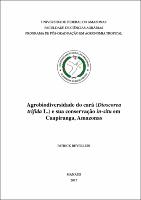| ???jsp.display-item.social.title??? |


|
Please use this identifier to cite or link to this item:
https://tede.ufam.edu.br/handle/tede/5717| ???metadata.dc.type???: | Tese |
| Title: | Agrobiodiversidade do cará (Dioscorea trifida L.) e sua conservação in-situ em Caapiranga, Amazonas |
| ???metadata.dc.creator???: | Beyerlein, Patrick  |
| ???metadata.dc.contributor.advisor1???: | Pereira, Henrique dos Santos |
| ???metadata.dc.contributor.referee1???: | Castro, Albejamere Pereira |
| ???metadata.dc.description.resumo???: | O cará (Dioscorea trifida L.) é uma planta alimentícia nativa da região amazônica. Diversas variedades locais são cultivadas nos agroecossistemas, porém, sujeitos aprocessos que podem estar causando erosão genética da espécie, correndo o risco de haver perdas de variedades antes que se possa reconhecer seus potenciais. A pesquisa que embasa a tese teve por objetivos registrar e analisar o conhecimento e as práticas a cerca da conservação in-situ da agrobiodiversidade do cará, identificar descritores morfológicos que discriminam variedades do cará, desenvolver uma chave de identificação para variedades, selecionar variedades com características agronômicas favoráveis, testar a viabilidade de sementes híbridas obtidas de polinizações controladas e avaliar a diversidade morfológica de plantas híbridas. Foram realizadas entrevistas semi-estruturadas com os produtores de cará gerando conhecimento sobre o manejo da agrobiodiversidade in-situ. A diversidade de variedades na principal região de produção do cará na Amazônia Central foi levantada com o método bola de neve. Foi instalado um plantio experimental com quatro blocos casualizados e quatro plantas por parcela com 20 variedades e realizada uma avaliação da diversidade morfológica e agronômica. Descritores morfológicos foram identificados que possibilitaram a criação de uma chave de identificação para as partes aéreas e subterrâneas das variedades estudadas. Houve diferencias significativos entre as variedades em relação à produção de tubérculos e aceitação pelos consumidores o que permitiu a identificação de variedades com elevado potencial agronômico. A dormência de sementes foi comprovada assim como a quebra da dormência após o armazenamento (maturidade pós-dispersão). Novos genótipos foram criados pelos cruzamentos que apresentaram alta variabilidade fenotípica e tubérculos com novas características. Os resultados fornecem ferramentas para a conservação da agrobiodiversidade e para o melhoramento genético, visando o resgate e a valorização das plantas alimentícias nativas da Amazônia. |
| Abstract: | The Amerindian yam (Dioscorea trifida L.) is a food plant native to the Amazon region. Local varieties are cultivated in agroecosystems.However, processes occur that may be causing genetic erosion of the species, running the risk of loss of varieties before knowing their potentials. The research of the thesis had as objectives to register and analyze in-situ conservation practices of the agrobiodiversity, to identify morphological descriptors that discriminate varieties, to develop identification keys for the varieties, to select varieties with favorable agronomic characteristics, to test the viability of hybrid seeds obtained from controlled pollinations and to evaluate the morphological diversity of the hybrid plants. Semi-structured interviews were conducted with the producers generating knowledge about the management of the in-situ agrobiodiversity. The diversity of varieties in the main production center of the Central Amazon region was raised using the snowball method. An experimental plantation with four randomized blocks and four plants per plot for 20 varieties was installed and evaluated the morphological diversityand agronomic characteristics. Sexual reproduction and seed germination were studied and carried out controlled pollinations between varieties and the hybrid plants generated were evaluated. Producer’s knowledge of diversity, propagation methods, exchange of propagating material and the local classification system of varieties were revealed. Morphological descriptors were identified that allowed the creation of an identification key for the aerial and subterranean parts of the local varieties studied. There were significant differences between the varieties in relation to the production of tubers and acceptance by the consumers, which allowed the identification of varieties with higher agronomic potential. Seed dormancy was confirmed and dormancy was broken bystorage (post-dispersion maturity). New genotypes were created by crossings that showed high phenotypic variability and tubers with new characteristics. The results provide tools for the conservation of agrobiodiversity and for genetic improvement, aiming at the rescue and valorization of the native food plants of the Amazon. |
| Keywords: | Amazônia Diversidade Variedades locais Cruzamentos Dioscoreacaea Diversity Native food plant Breeding |
| ???metadata.dc.subject.cnpq???: | CIÊNCIAS AGRÁRIAS: AGRONOMIA |
| Language: | por |
| ???metadata.dc.publisher.country???: | Brasil |
| Publisher: | Universidade Federal do Amazonas |
| ???metadata.dc.publisher.initials???: | UFAM |
| ???metadata.dc.publisher.department???: | Faculdade de Ciências Agrárias |
| ???metadata.dc.publisher.program???: | Programa de Pós-graduação em Agronomia Tropical |
| Citation: | BEYERLEIN, Patrick. Agrobiodiversidade do cará (Dioscorea trifida L.) e sua conservação in-situ em Caapiranga, Amazonas. 2017. 131 f. Tese (Doutorado em Agronomia Tropical) - Universidade Federal do Amazonas, Manaus, 2017. |
| ???metadata.dc.rights???: | Acesso Aberto |
| ???metadata.dc.rights.uri???: | http://creativecommons.org/licenses/by-nc-nd/4.0/ |
| URI: | http://tede.ufam.edu.br/handle/tede/5717 |
| Issue Date: | 24-Mar-2017 |
| Appears in Collections: | Doutorado em Agronomia Tropical |
Files in This Item:
| File | Description | Size | Format | |
|---|---|---|---|---|
| Tese_Patrick Beyerlein.pdf | 5.96 MB | Adobe PDF |  Download/Open Preview |
This item is licensed under a Creative Commons License





